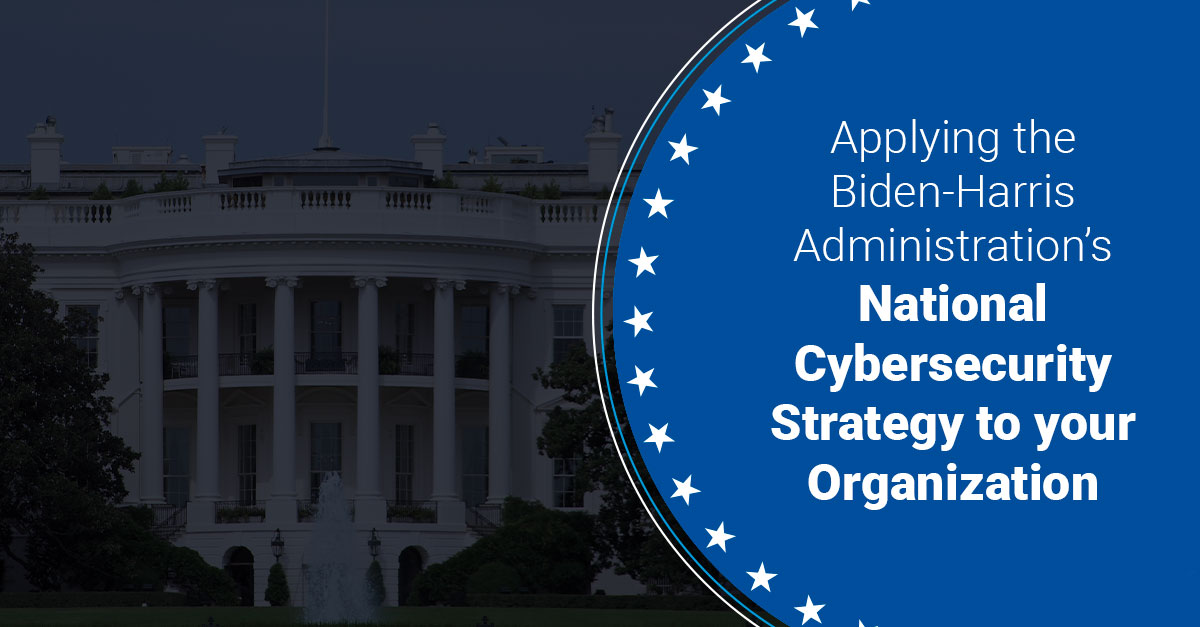Applying the Biden-Harris Administration’s National Cybersecurity Strategy to your Organization in Five Steps

As cyber threats continue to evolve and grow, it is increasingly clear that a coordinated and comprehensive approach to cybersecurity is necessary. Governments around the world have recognized the need for national cybersecurity strategies to protect their citizens, businesses, and critical infrastructure. In this article, we will explore the importance of a national cybersecurity strategy from the perspective of a cyber threat intelligence team.
Understanding the Importance of National Cybersecurity Strategy
The increasing frequency and severity of cyberattacks have highlighted the importance of having a comprehensive national cybersecurity strategy. Cyberattacks can result in the loss of sensitive data, disruption of critical services, financial losses, reputational damage, and even loss of life. A national cybersecurity strategy is essential to protect against cyber threats, safeguard national security, and maintain economic stability. It provides a framework for coordinating and prioritizing efforts to address cyber threats, promotes information sharing and collaboration, and enables rapid response to incidents.
The Elements of the Biden-Harris Administration’s National Cybersecurity Strategy
A national cybersecurity strategy should be based on a comprehensive understanding of the threat landscape and the potential impact of cyberattacks. The Biden-Harris Administration’s National Cybersecurity Strategy recognizes the complexity of the threat environment and sets out a path to address these threats and secure the promise of our digital future. It is based on a comprehensive understanding of the threat landscape and potential impact of cyberattacks and seeks to build and enhance collaboration around five pillars.
The first pillar is to defend critical infrastructure, where the American people must have confidence in the availability and resilience of critical infrastructure and essential services. The expansion of minimum cybersecurity requirements in critical sectors ensures national security and public safety while harmonizing regulations to reduce the burden of compliance. Public-private collaboration must be enabled at the speed and scale necessary to defend critical infrastructure and essential services. Additionally, the federal networks must be defended and modernized while updating the federal incident response policy.
The second pillar is to disrupt and dismantle threat actors. Using all instruments of national power, malicious cyber actors must be made incapable of threatening the national security or public safety of the United States. Strategically employing all tools of national power to disrupt adversaries and engaging the private sector in disruption activities through scalable mechanisms must be prioritized. Addressing the ransomware threat through a comprehensive federal approach and in lockstep with our international partners is also essential.
The third pillar is to shape market forces to drive security and resilience. Responsibility must be placed on those within our digital ecosystem that are best positioned to reduce risk, and the consequences of poor cybersecurity must shift away from the most vulnerable. Promoting privacy and the security of personal data, shifting liability for software products and services to promote secure development practices, and ensuring that federal grant programs promote investments in new infrastructure that are secure and resilient must be prioritized.
The fourth pillar is to invest in a resilient future. Through strategic investments and coordinated, collaborative action, the United States will continue to lead the world in the innovation of secure and resilient next-generation technologies and infrastructure. Reducing systemic technical vulnerabilities in the foundation of the internet and across the digital ecosystem while making it more resilient against transnational digital repression, prioritizing cybersecurity research and development (R&D) for next-generation technologies, such as postquantum encryption, digital identity solutions, clean energy infrastructure, and developing a diverse and robust national cyber workforce are all crucial elements.
Finally, the fifth pillar is to forge international partnerships to pursue shared goals. The United States seeks a world where responsible state behavior in cyberspace is expected and reinforced, and where irresponsible behavior is isolating and costly. Leveraging international coalitions and partnerships among like-minded nations to counter threats to our digital ecosystem through joint preparedness, response, and cost imposition, increasing the capacity of our partners to defend themselves against cyber threats, both in peacetime and in crisis, and working with allies and partners to make secure, reliable, and trustworthy global supply chains for information and communications technology and operational technology products and services.
Key Takeaways for Strategic, Operational, and Tactical Level Intelligence Operations
At the strategic level, a national cybersecurity strategy provides a framework for allocating resources and prioritizing efforts to address cyber threats. It enables the identification and assessment of threats, vulnerabilities, and risks and facilitates the development of policies and strategies to mitigate them. For example, the Biden-Harris Administration’s National Cybersecurity Strategy sets out a path to address cyber threats and secure the promise of our digital future. Its implementation will protect investments in rebuilding America’s infrastructure, developing the clean energy sector, and re-shoring America’s technology and manufacturing base.
At the operational level, a national cybersecurity strategy promotes information sharing and collaboration between government agencies, private sector organizations, and international partners. It facilitates the implementation of policies and strategies to address cyber threats, such as incident response plans, and enables the coordination of activities to detect, prevent, and respond to cyberattacks. For example, the Biden-Harris Administration’s National Cybersecurity Strategy seeks to build and enhance collaboration around five pillars, including defending critical infrastructure, disrupting and dismantling threat actors, shaping market forces to drive security and resilience, investing in a resilient future, and forging international partnerships to pursue shared goals.
At the tactical level, a national cybersecurity strategy provides guidance and resources to enable organizations to implement cybersecurity best practices, such as secure software development and network security. It facilitates the sharing of threat intelligence and enables organizations to respond rapidly to cyberattacks. For example, the Biden-Harris Administration’s National Cybersecurity Strategy promotes the implementation of minimum cybersecurity requirements in critical sectors to ensure national security and public safety while harmonizing regulations to reduce the burden of compliance.
Applying the National Cybersecurity Strategy to Your Organization
The Biden-Harris Administration’s National Cybersecurity Strategy provides a comprehensive framework for addressing cyber threats at the national level, but it is equally applicable to businesses and organizations of all sizes. To apply the strategy to your organization, consider the following steps:
- Conduct a cybersecurity risk assessment to identify and assess the threats, vulnerabilities, and risks facing your organization. This will help you prioritize your cybersecurity efforts and allocate resources more effectively.
- Develop a cybersecurity strategy that prioritizes the protection of critical assets and enables the rapid detection, prevention, and response to cyberattacks. Your strategy should be based on a comprehensive understanding of the threat landscape and potential impact of cyberattacks.
- Implement cybersecurity best practices, such as secure software development and network security, to reduce the risk of cyberattacks. Your strategy should include guidance on implementing best practices and should be regularly reviewed and updated as threats evolve.
- Foster a culture of cybersecurity awareness and training among employees to ensure that they understand the importance of cybersecurity and their role in protecting the organization. Regular training and awareness campaigns can help employees identify and report suspicious activity.
- Collaborate with industry partners, government agencies, and international partners to share threat intelligence, best practices and to promote a more secure digital ecosystem. Cyberthreats are a global issue, and it is essential to work together to address them. Joining industry groups, participating in information-sharing programs, and collaborating with government agencies and international partners can help you stay up to date on the latest threats and vulnerabilities and implement best practices to protect your business.
Conclusion: Building a Values-Aligned Digital Ecosystem
As the world becomes increasingly interconnected and reliant on digital technology, the importance of cybersecurity has become increasingly clear. A national cybersecurity strategy is essential to protect against cyber threats, safeguard national security, and maintain economic stability. The Biden-Harris Administration’s National Cybersecurity Strategy provides a comprehensive framework for addressing cyber threats at the national level, and it is equally applicable to businesses of all sizes. By applying the strategy to your business, you can reduce the risk of cyberattacks and promote a more secure digital ecosystem.
Cyber threats are an ever-present and evolving risk, and it is essential to have a comprehensive approach to cybersecurity. A national cybersecurity strategy provides a framework for coordinating and prioritizing efforts to address cyber threats, promotes information sharing and collaboration, and enables rapid response to incidents. At the strategic level, a national cybersecurity strategy provides a framework for allocating resources and prioritizing efforts to address cyber threats. At the operational level, it promotes information sharing and collaboration. And at the tactical level, it provides guidance and resources to enable organizations to implement cybersecurity best practices.
The five pillars of the Biden-Harris Administration’s National Cybersecurity Strategy provide a roadmap for achieving a defensible, resilient, and values-aligned digital ecosystem, and organizations of all sizes can benefit from applying its principles to their own cybersecurity strategies. By working together, we can build a more defensible, resilient, and values-aligned digital ecosystem.
To learn more about how we can help support your organization’s cybersecurity strategy by simplifying breach prevention and stopping business disruptions, contact us today.
RESOURCE CATEGORIES
- Buyer's Guides(1)
- Consumer Education(39)
- Consumer Stories(2)
- Cybersecurity Consulting(4)
- Data Breaches(15)
- Data Privacy(43)
- Incident Response(2)
- Interview(51)
- MDR Services(59)
- MobileSOC(6)
- News(5)
- Press Release(101)
- Research Report(9)
- Security Assessments(2)
- Thought Leadership(19)
- Threat Hunting(3)
- Video(1)
- Vulnerability Disclosure(1)
